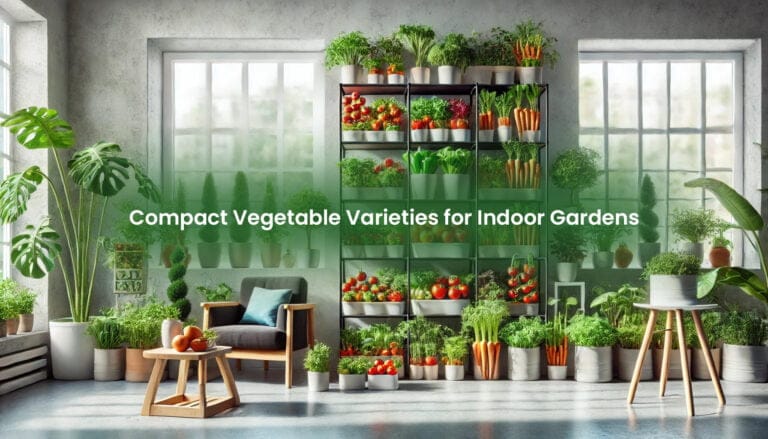Table of contents
- Introduction
- 1. Benefits of Growing Compact Vegetables Indoors
- 2. Top Compact Vegetable Varieties for Indoor Gardens
- 3. Compact Vegetable Varieties and Their Growing Conditions
- 4. Setting Up Your Indoor Garden for Success
- 5. Maintenance and Troubleshooting Common Issues
- 6. Conclusion
- 7. Benefits of Indoor Gardening
Introduction
Welcome to the world of indoor gardening! You’re in the right place if you’re limited on space but love growing your vegetables. Did you know urban gardening has increased by over 30% recently? That’s right! More people are turning their homes into green sanctuaries. This article explores the best compact vegetable varieties that thrive indoors, ensuring you can enjoy fresh produce no matter how small your living area is.
1. Benefits of Growing Compact Vegetables Indoors
Space Efficiency: Maximize Small Living Areas
Indoor gardening allows you to make the most of limited space. Compact vegetable varieties are designed to thrive in confined areas, making them perfect for apartments, tiny homes, or even just a windowsill. With the correct setup, you can transform any small corner into a productive garden. Try vertical gardening techniques and stacking pots to maximize your growing area. Imagine having a mini vegetable oasis right in your living room! For more detailed tips on creating your own vertical garden setup, check out our step-by-step guide to vertical gardening on Backyard Farmer.
Fresh Produce Year-Round: Enjoy Homegrown Veggies Anytime
One of the biggest perks of indoor gardening is the ability to grow fresh produce all year. Forget about the seasons—your indoor garden can flourish with the proper care. This means you can enjoy juicy tomatoes, fragrant herbs, and crunchy greens even in winter. With controlled indoor conditions, you’re not at the mercy of unpredictable weather, ensuring a constant supply of nutritious vegetables.
Health Benefits: Boost Your Diet with Fresh, Nutritious Food
Growing your vegetables means you have access to the freshest, most nutritious produce possible. Homegrown vegetables are often richer in vitamins and minerals than store-bought ones. Plus, indoor gardening can be incredibly therapeutic, reducing stress and promoting mental well-being. And there’s nothing quite like the satisfaction of eating food you’ve grown yourself!
Aesthetic Appeal: Enhance Your Home’s Decor with Greenery
Compact vegetable plants add a touch of nature to your indoor spaces, making them more vibrant and inviting. Whether it’s a sunny kitchen window filled with herbs or a living room corner with lush green plants, indoor gardening enhances the aesthetic appeal of your home. Stylish containers and creative arrangements can turn your indoor garden into a beautiful, eye-catching feature.
2. Top Compact Vegetable Varieties for Indoor Gardens
Miniature Tomatoes
Varieties: Tiny Tim, Micro-Tom
Miniature tomatoes, like Tiny Tim and Micro-Tom, are perfect for indoor gardens. These varieties are bred to be small yet productive, often yielding a generous crop of cherry-sized tomatoes. They can be grown in small pots or hanging baskets, requiring minimal space. Regular pruning and proper support will help maintain their compact size.
Growth Habits and Care Tips
Miniature tomatoes need a sunny spot with at least 6-8 hours of direct sunlight or adequate grow lights. They prefer well-draining soil and regular watering, keeping the soil consistently moist but not soggy. Fertilize with a balanced, water-soluble fertilizer every two weeks to encourage healthy growth and fruit production.
Baby Carrots
Varieties: Parisian, Adelaide
Baby carrots such as Parisian and Adelaide are ideal for indoor gardening due to their short root systems. These varieties quickly mature and can be harvested in as little as 30 days. They thrive in deep containers that provide enough room for root development.
Ideal Growing Conditions
Carrots need loose, well-draining soil and plenty of light. To prevent malformed roots, use deep containers and avoid rocky or compacted soil. Water consistently to keep the soil moist, and thin seedlings to avoid overcrowding. Carrots prefer cooler temperatures, so ensure they are not exposed to excessive heat.
Dwarf Peppers
Varieties: Lunchbox, Sweet Pickle
Dwarf pepper varieties like Lunchbox and Sweet Pickle are perfect for indoor growing. These compact plants produce small, sweet peppers that are excellent for snacking and cooking. They are also visually appealing, adding a splash of color to your indoor garden.
Light and Watering Needs
Peppers need plenty of sunlight, ideally 8-10 hours of direct sunlight daily. If natural light is insufficient, supplement with grow lights. Water regularly, ensuring the soil is well-drained. Avoid overwatering, as peppers are susceptible to root rot. Fertilize every two weeks with a balanced fertilizer to support their growth.
Microgreens
Types: Arugula, Radish, Kale
Microgreens are young vegetable greens that are harvested shortly after sprouting. Varieties like arugula, radish, and kale are popular choices. They are nutrient-dense and can be grown in small trays, making them perfect for indoor gardening.
Quick Growth and Harvesting Tips
Microgreens grow quickly and are often ready to harvest in just 1-2 weeks. They require shallow trays filled with a soilless growing medium. Sprinkle seeds evenly and cover lightly with more medium. Water gently and place in a bright location. Once the first true leaves appear, they are ready to harvest by cutting just above the soil line.
Herbs
Best Picks: Basil, Chives, Mint
Herbs like basil, chives, and mint are excellent choices for indoor gardening. They are compact, easy to grow, and highly versatile in the kitchen. Each herb has unique growing requirements but generally thrives in well-lit indoor environments. If you’re interested in exploring other compact vegetable varieties suitable for small spaces, read our comprehensive article on How to grow Tomatoes indoors.
Maintenance and Usage in Cooking
Herbs need at least 6 hours of sunlight daily. Use well-draining soil and pots with good drainage. Water when the soil feels dry to the touch. Regularly trim and harvest the herbs to encourage bushy growth. Fresh herbs can elevate your cooking, adding vibrant flavors to various dishes.
3. Compact Vegetable Varieties and Their Growing Conditions
| Vegetable | Varieties | Light Requirements | Watering Needs | Soil Type | Special Tips |
|---|---|---|---|---|---|
| Miniature Tomatoes | Tiny Tim, Micro Tom | 6-8 hours of direct sunlight or grow lights | Consistently moist, well-drained | Well-draining soil | Regular pruning, support with stakes |
| Baby Carrots | Parisian, Adelaide | Plenty of light | Consistently moist | Loose, well-draining soil | Thin seedlings to avoid overcrowding |
| Dwarf Peppers | Lunchbox, Sweet Pickle | 8-10 hours of direct light | Regular watering, well-drained | Well-draining soil | Avoid overwatering, fertilize bi-weekly |
| Microgreens | Arugula, Radish, Kale | Bright light | Gently water | Soilless growing medium | Harvest when first true leaves appear |
| Herbs | Basil, Chives, Mint | 6 hours of sunlight | Water when soil is dry | Well-draining soil | Regular trimming to encourage growth |
4. Setting Up Your Indoor Garden for Success
Choosing the Right Containers
Selecting appropriate containers is crucial for indoor gardening success. Containers should be the right size for your plants and have adequate drainage holes. Options like self-watering pots, hanging baskets, and vertical planters can maximize your space and ensure your plants thrive.
Optimizing Light Conditions: Natural Light vs. Grow Lights
Light is a critical factor in indoor gardening. While natural sunlight is ideal, not all indoor spaces receive sufficient light. In such cases, grow lights are a great alternative. LED grow lights are energy-efficient and provide the full spectrum of light needed for plant growth. Position grow lights 6-12 inches above your plants and adjust them based on their growth stage. According to the experts at Gardening Know How, using LED grow lights can significantly enhance plant growth in indoor gardens, ensuring your vegetables receive the optimal light spectrum.
Soil and Fertilization Tips
Using the right soil mix is essential for indoor plants. Choose a high-quality, well-draining potting mix. Avoid garden soil, which can be too heavy and may harbor pests. Regular fertilization is essential for maintaining healthy plants. Use a balanced, water-soluble fertilizer every 2-4 weeks, depending on the plant’s needs.
Watering Techniques to Prevent Overwatering
Proper watering is crucial for indoor gardening. Overwatering is a common issue that can lead to root rot. Water plants when the top inch of soil feels dry. Ensure pots have good drainage to prevent water from accumulating at the bottom. Using a moisture meter can help you determine when your plants need water.
Pest Control Strategies for Indoor Plants
Indoor plants can still be harmed by pests like aphids, spider mites, and fungus gnats. Regularly inspect your plants for signs of pests. Use natural remedies like neem oil or insecticidal soap to treat infestations. Proper plant care can also reduce the likelihood of pest problems. For additional information on maintaining plant health and preventing common indoor pests, the Royal Horticultural Society provides excellent resources and advice tailored to home gardeners.
5. Maintenance and Troubleshooting Common Issues
Pruning and Supporting Your Plants
Pruning helps keep your indoor plants healthy and promotes better growth. Regularly remove dead or yellowing leaves and trim back overgrown areas. Supporting plants with stakes or trellises can help them grow upright and prevent heavy fruits or foliage damage.
Recognizing and Treating Common Pests
Common indoor plant pests include aphids, spider mites, and whiteflies. Signs of infestation include yellowing leaves, sticky residue, and visible insects. Treat pests early with insecticidal soap and neem oil or by physically removing them. Maintaining good plant hygiene and proper care can prevent pest problems.
Managing Diseases in Indoor Plants
Indoor plants can suffer from diseases like powdery mildew, root rot, and leaf spot. These are often caused by overwatering, poor ventilation, or contaminated soil. To manage diseases, ensure proper watering, improve air circulation, and remove affected leaves or plants. Using sterile soil and clean pots can also help prevent disease.
Tips for Consistent Growth and Productivity
Consistency in care is critical to successful indoor gardening. Establish a routine for watering, feeding, and inspecting your plants. Keep a gardening journal to track growth and identify patterns. Adjust care practices based on the seasons and your plants’ needs to ensure continuous growth and productivity.
6. Conclusion
Indoor gardening is a rewarding and practical way to enjoy fresh vegetables year-round, even in small spaces. By choosing compact varieties and following these tips, you can create a thriving indoor garden that enhances your home and provides delicious, nutritious produce. Happy gardening!
7. Benefits of Indoor Gardening
| Benefit | Description |
|---|---|
| Space Efficiency | Utilize vertical gardening and stacking pots to maximize small spaces |
| Fresh Produce Year-Round | Grow vegetables regardless of season, ensuring a constant supply of fresh produce |
| Health Benefits | Homegrown vegetables are richer in vitamins; gardening reduces stress |
| Aesthetic Appeal | Enhance home decor with vibrant, lush green plants |





